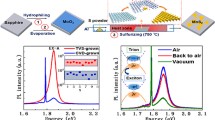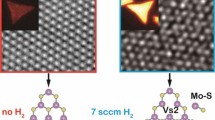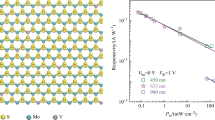Abstract
Two-dimensional (2D) transition metal dichalcogenide (TMDC) materials are considered as promising candidates to extend Moore’s Law. However, the low photoluminescence (PL) quantum yield due to the inevitable defects during material preparation severely restricts its practical applications. Here, we report an effective defect engineering strategy for Sr-doped MoS2 that has been successfully achieved by a facile one-step chemical vapor deposition (CVD) method. PL enhancement up to two orders of magnitude, along with prolonged carrier lifetime, is obtained by do** the sample with a lateral size up to sub-millimeter level (∼324 µm). Such an observed phenomenon is attributed to the transformation of negative trions to neutral excitons. Meanwhile, the radiation quality and stability of the doped samples are significantly improved. First-principles calculations further elucidate the underlying mechanism, that is, the introduction of appropriate complementary defect energy levels in MoS2 synergizes with its own defect energy levels to enhance the PL emission, rather than a simple do** effect. In addition, our defect strategy can also be applied to other dopant like calcium atoms. Our work demonstrates an effective defect engineering strategy to improve the PL performance of 2D TMDCs, which provides a promising approach for designing and engineering their optoelectronic properties for potential applications.

摘要
二维过渡金属硫族化合物(TMDCs)材料被认为是拓展摩尔定律 的极具前景的候选材料. 然而, 该材料的低光致发光效率严重限制了其 实际应用, 其本质源于材料制备中不可避免引入的缺陷. 在本文中, 我 们报道了一种Sr掺杂单层MoS2的有效缺陷工程策略, 该策略在实验上 通过简便的化学气相沉积(CVD)一步法成功实现. 所制备的具有亚毫 米(∼324 μm)级的大尺寸样品的光致发光可实现高达两个数量级的增 **, 并伴随着载流子寿命的显著增**. 这一现象主要归因于Sr掺杂后 MoS2体系中其三激子向激子转换. 与此同时, 掺杂样品的辐射质量和 稳定性也显著提升. 第一性原理计算进一步阐明了其调控机制, 即在 MoS2中引入适当互补缺陷能级与其自身的缺陷能级协同, 从而可调节 其载流子组分, 以实现光致发光的显著增**. 此外, 我们的缺陷工程策 略也适用于其他掺杂剂, 如钙掺杂剂. 我们的工作报告了一种可以显著 提升单层MoS2的荧光性能的有效缺陷工程策略, 这为设计和调控二维 TMDCs的光电特性提供一种极具前途的方法.
Similar content being viewed by others
References
Wang S, Liu X, Xu M, et al. Two-dimensional devices and integration towards the silicon lines. Nat Mater, 2022, 21: 1225–1239
Jiang Y, Chen S, Zheng W, et al. Interlayer exciton formation, relaxation, and transport in TMD van der Waals heterostructures. Light Sci Appl, 2021, 10: 72
Mak KF, Shan J. Photonics and optoelectronics of 2D semiconductor transition metal dichalcogenides. Nat Photon, 2016, 10: 216–226
Mak KF, Lee C, Hone J, et al. Atomically thin MoS2: A new direct-gap semiconductor. Phys Rev Lett, 2010, 105: 136805
Li F, Feng Y, Li Z, et al. Rational kinetics control toward universal growth of 2D vertically stacked heterostructures. Adv Mater, 2019, 31: 1901351
Amani M, Lien DH, Kiriya D, et al. Near-unity photoluminescence quantum yield in MoS2. Science, 2015, 350: 1065–1068
Lien DH, Uddin SZ, Yeh M, et al. Electrical suppression of all non-radiative recombination pathways in monolayer semiconductors. Science, 2019, 364: 468–471
Chen Y, Liu H, Yu G, et al. Defect engineering of 2D semiconductors for dual control of emission and carrier polarity. Adv Mater, 2024, 36: 2312425
Zhou W, Zou X, Najmaei S, et al. Intrinsic structural defects in monolayer molybdenum disulfide. Nano Lett, 2013, 13: 2615–2622
Liu B, Chen Y, Ma C, et al. Gallium do**-assisted giant photoluminescence enhancement of monolayer MoS2 grown by chemical vapor deposition. Appl Phys Lett, 2022, 120: 221902
Cui Q, Luo Z, Cui Q, et al. Robust and high photoluminescence in WS2 monolayer through in situ defect engineering. Adv Funct Mater, 2021, 31: 2105339
Tanoh AOA, Alexander-Webber J, **ao J, et al. Enhancing photoluminescence and mobilities in WS2 monolayers with oleic acid ligands. Nano Lett, 2019, 19: 6299–6307
Amani M, Taheri P, Addou R, et al. Recombination kinetics and effects of superacid treatment in sulfur- and selenium-based transition metal dichalcogenides. Nano Lett, 2016, 16: 2786–2791
Ross JS, Wu S, Yu H, et al. Electrical control of neutral and charged excitons in a monolayer semiconductor. Nat Commun, 2013, 4: 1474
Kim H, Ahn GH, Cho J, et al. Synthetic WSe2 monolayers with high photoluminescence quantum yield. Sci Adv, 2019, 5: eaau4728
Zheng B, Zheng W, Jiang Y, et al. WO3-WS2 vertical bilayer heterostructures with high photoluminescence quantum yield. J Am Chem Soc, 2019, 141: 11754–11758
Zhou J, Lin J, Huang X, et al. A library of atomically thin metal chalcogenides. Nature, 2018, 556: 355–359
Chen Y, Jiang Y, Yi C, et al. Efficient control of emission and carrier polarity in WS2 monolayer by indium do**. Sci China Mater, 2021, 64: 1449–1456
Qin Z, Loh L, Wang J, et al. Growth of Nb-doped monolayer WS2 by liquid-phase precursor mixing. ACS Nano, 2019, 13: 10768–10775
Zhang L, Wang G, Zhang Y, et al. Tuning electrical conductance in bilayer MoS2 through defect-mediated interlayer chemical bonding. ACS Nano, 2020, 14: 10265–10275
Zhang F, Lu Y, Schulman DS, et al. Carbon do** of WS2 monolayers: Bandgap reduction and p-type do** transport. Sci Adv, 2019, 5: eaav5003
Li Z, Li D, Wang H, et al. Universal p-type do** via lewis acid for 2D transition-metal dichalcogenides. ACS Nano, 2022, 16: 4884–4891
Wang Z, Tripathi M, Golsanamlou Z, et al. Substitutional p-type do** in NbS2-MoS2 lateral heterostructures grown by MOCVD. Adv Mater, 2023, 35: 2209371
Kresse G, Furthmüller J. Efficient iterative schemes for ab initio total-energy calculations using a plane-wave basis set. Phys Rev B, 1996, 54: 11169–11186
Perdew JP, Burke K, Ernzerhof M. Generalized gradient approximation made simple. Phys Rev Lett, 1997, 78: 1396
Blöchl PE. Projector augmented-wave method. Phys Rev B, 1994, 50: 17953–17979
Kresse G, Joubert D. From ultrasoft pseudopotentials to the projector augmented-wave method. Phys Rev B, 1999, 59: 1758–1775
Chen MX, Weinert M. Revealing the substrate origin of the linear dispersion of silicene/Ag(111). Nano Lett, 2014, 14: 5189–5193
Lee YH, Zhang XQ, Zhang W, et al. Synthesis of large-area MoS2 atomic layers with chemical vapor deposition. Adv Mater, 2012, 24: 2320–2325
Gao J, Kim YD, Liang L, et al. Transition-metal substitution do** in synthetic atomically thin semiconductors. Adv Mater, 2016, 28: 9735–9743
Tongay S, Zhou J, Ataca C, et al. Broad-range modulation of light emission in two-dimensional semiconductors by molecular physisorption gating. Nano Lett, 2013, 13: 2831–2836
Sebait R, Biswas C, Song B, et al. Identifying defect-induced trion in monolayer WS2 via carrier screening engineering. ACS Nano, 2021, 15: 2849–2857
Mak KF, He K, Lee C, et al. Tightly bound trions in monolayer MoS2. Nat Mater, 2013, 12: 207–211
Kaplan D, Gong Y, Mills K, et al. Excitation intensity dependence of photoluminescence from monolayers of MoS2 and WS2 /MoS2 heterostructures. 2D Mater, 2016, 3: 015005
Hu Z, Wu Z, Han C, et al. Two-dimensional transition metal dichalcogenides: interface and defect engineering. Chem Soc Rev, 2018, 47: 3100–3128
Lee Y, Tran TT, Kim Y, et al. Enhanced radiative exciton recombination in monolayer WS2 on the hBN substrate competing with non-radiative exciton-exciton annihilation. ACS Photonics, 2022, 9: 873–879
Acknowledgements
This work was supported by the National Natural Science Foundation of China (62375079, 52072117, 62375081, 52221001, 51972105, 62090035, U19A2090, and 61905071), the National Key R&D Program of China (2022YFA1204300), the Key Program of Science and Technology Department of Hunan Province (2019XK2001 and 2020XK2001), the Key Research and Development Plan of Hunan Province (2023GK2012), the Open Project Program of Key Laboratory of Nanodevices and Applications, Suzhou Institute of Nano-Tech and Nano-Bionics, Chinese Academy of Sciences (22ZS01), the Hunan Provincial Natural Science Foundation of China (2021JJ30132), and the China Scholarship Council.
Author information
Authors and Affiliations
Contributions
Author contributions Chen Y, Huang Z, Jiang Y, Chen S and Pan A conceived and designed this project, and wrote and revised the manuscript. Yu G and Chen M carried out DFT theoretical calculations. Zhang J, Xu Z, Li D, Ma C and Zhu X performed AFM, SEM, STEM, PL, Raman and TRPL measurements and provided recommendations for data analysis. Jiang Y, Chen S and Pan A supervised the experiments and provided theoretical guidance. All authors contributed to the general discussion.
Corresponding authors
Ethics declarations
Conflict of interest The authors declare that they have no conflict of interest.
Additional information
Supplementary information Experimental details and supporting data are available in the online version of the paper.
Ying Chen is currently a PhD candidate at the College of Materials Science and Engineering, Hunan University. His main research interests include the synthesis of nanomaterials with controlled CVD route and their applications in optoelectric devices
Zhuorui Huang is currently a Master student at the College of Materials Science and Engineering, Hunan University. His main research interests include the synthesis of 2D materials and their applications in optoelectric devices.
Shula Chen received his PhD degree from the Department of Physics, Linkö** University, Sweden, in 2014. After that, he worked as a postdoctoral researcher at the Graduate School of Information Science and Technology, Hokkaido University, Japan. Later on, in 2016, he returned to Linkö** University and became a lecturer. In 2019, He joined the College of Materials Science and Engineering, Hunan University as a professor. Currently, his main research interests cover nano-photonics of III-V-based semiconductors, opto-spintronic properties and device applications of emerging 2D semiconductors and low-dimensional perovskite materials.
Ying Jiang received the MS degree in electronics and systems from Jilin University in 2010 and her PhD degree in physical chemistry from Instituto Superior Tecnico, University of Lisbon, in 2015. She is currently an associate professor in School of Physics and Electronics, Hunan University. Her current research interests focus on the ultrafast spectroscopic study of 2D transition metal dichalcogenides materials and perovskite nanostructures.
Anlian Pan received his PhD degree from the Institute of Physics, Chinese Academy of Sciences in 2006. Afterwards, he worked for one year as a Humboldt Research Fellow with Prof. Ulrich Goesele at Max Planck Institute of Microstructure Physics, and then joined Arizona State University as a Postdoctoral Fellow, where he became a research assistant professor. He came back to Hunan University in 2010 and had been working as the distinguished professor of “Furong” scholar in Hunan province since then. His research interests include the micronano optical, and electronics of semiconductor nanostructures.
Supplementary information
Rights and permissions
About this article
Cite this article
Chen, Y., Huang, Z., Liu, H. et al. An effective defect engineering strategy for giant photoluminescence enhancement of MoS2 monolayers. Sci. China Mater. (2024). https://doi.org/10.1007/s40843-024-2974-7
Received:
Accepted:
Published:
DOI: https://doi.org/10.1007/s40843-024-2974-7




